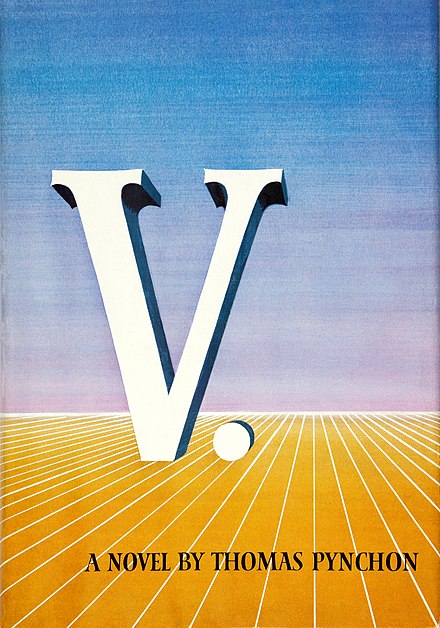Pynchon Works: “V.”

In which the yo-yo string is revealed as a state of mind
Thomas Pynchon’s V.
V.
J. B. Lippincott & Co., 1963.
V.
Harper Collins “Perennial Classics” edition, 2005.
V. is Pynchon’s first novel. Published in 1963, it won the William Faulkner Foundation First Novel Award, and immediately established Pynchon as a Talent to Watch—a promise which he’d certainly fulfill a decade later. Indeed, V. is in many ways a precursor to Gravity’s Rainbow, and it clearly shows Pynchon’s growth as a writer from his short story years. V. is a sprawling novel, filled with a colorful cast of characters whose various adventures and interactions range across a century. Despite their overwhelming numbers, Pynchon takes great care in investing each character with a remarkable degree of depth and vibrancy, and even the most incidental of them are painted with just enough detail to make them believable. It also highlights his developing skill at juxtaposing opposites to achieve a satirical effect—the comic and the tragic, the sacred and the profane, the meaningful and the meaningless. Many of the themes that would be explored more thoroughly in Gravity’s Rainbow are first visited here, and some of the characters and situations featured in the latter work are first introduced in V.
It’s difficult to actually describe V. Taking the year 1956 as its “present,” the book alternates between this time period and various episodes set in years ranging from 1898 to 1944. The episodes are not chronological, however they do frequently involve the same characters. Imagine a snapshot taken of the twentieth century and the years just preceding it, a magical photograph that encompasses the whole globe and spans nearly 60 years. Due to the wondrous nature of this snapshot, we can trace the life of a single person as they move through time and space; and at various points, we can observe the impact they have on their surroundings as well the effects their actions have on the others around them. We are able to see causes and effects laid out all at once, as if we’re looking at a film spread out in front of us rather than viewing it frame by frame. Like gods, we can sort out the tangle of relationships, looking for patterns, similarities, and root causes; and, from this omniscient viewpoint, we also see that certain people almost perfectly embody their indigenous time and place, while others seem lost, misplaced…
V. is a work that internalizes this idea as something akin to a hidden structure or an inner landscape. And yet, because it is only a book, we must read it one page at a time, and we can only follow the actions of a handful of characters. But though V. limits itself to only a specific group of people and their permutations, it does not constrain itself to complete linearity. Instead we focus on individual scenes at different times and places in this “snapshot,” like taking random samplings of data to create a statistical picture of the whole pattern.
Central to the novel are two very opposite characters. The first we meet is Benny Profane, a discharged Navy man. Benny considers himself something of a loser, a “schlemihl,” and spends most of his time drifting from one hard-luck situation into an other. A man who lives completely in the here and now, in many ways he typifies what Pynchon terms the “preterite,” and those who have read his short stories will immediately recognize him, for we’ve met his brothers before in Lardass Levine, Dennis Flange, and Meatball Mulligan, and we will meet his descendants in Tyrone Slothrop and Zoyd Wheeler. Frequently described as a human yo-yo, Benny is at odds with a world he largely considers inanimate—the world of objects takes no pity on schlemihls. Indeed, one of Benny’s fears is that people, too, can become inanimate, drifting along the path to dehumanization in varying degrees of complicity. Indeed, this is one of the central issues of the book itself, and is reformulated throughout V. by almost all the characters, including members of The Whole Sick Crew, Benny’s sometimes circle of friends. While a fairly cheerful lot, none of whom would feel out of place at Meatball Mulligan’s Lease-breaking party, The Crew nevertheless are emblematic of artistic decadence—a lost generation, they seem more content with sterile arguments about life than actually living it.
The other character is more complex than Profane, but is farther removed from the experiences of common fellows like Profane and the Crew. His name is Herbert Stencil, a man who is obsessed with unravelling the diaries of his father, a diplomat and spy from the British Foreign Office. Caught in the latter half of the twentieth century, the grim and edgy Stencil lives his father’s life vicariously through a quest for V., an enigmatic figure mentioned in his diaries. With cheerless and occasionally flagging determination, Stencil travels the world, interviewing anyone who may hold a key to his quest. Unfortunately for him, he finds that the past means increasingly less to people, and as entropy takes over, it blurs and obscures past relationships, past alliances, and even past lessons. It is this self-imposed quest that drives the episodic parts of the novel, shifting its focus through time and space. We are also never quite sure if these episodes are “objective” narrative, or have becomes “Stencilized,” tales distorted by Stencil’s obsession with V.
But who, or what, is V.? All throughout the novel, the initial V. emerges as a symbol for something to be pursued, to be wooed and won, to be cherished, to be possessed, or to be regained—but never to any avail. According to Stencil’s “episodes,” his V. would seem to be a mysterious woman, deliberately pursuing the path of the Inanimate as the old order gives painful birth to the horrors and exhaustions of Modernity. Siren-like, exerting a thrall over men and women alike, she seems to contain the opposing forces of stagnation and riot in a pressurized alembic, appearing at historical moments of decadence and revolution. And yet her motives are unclear; and even her nature and identity seem indeterminate, like a quantum particle holding within the secrets of wave and particle, subverting any attempts at definition with a blurring of properties. By the end of the work, even Stencil himself admits, “V. was by this time a remarkable scattered concept.” A mistress, a mother, a whore or a priestess? But always female—even when she may be a lost geographical Eden named Vheissu, she is considered in female terms. Like the exiled Shekinah, or the female half of God the gnostics called Sophia and the Qabalists believed was imprisoned in the matrix of the physical universe, V. seems more like a lost promise than an actual figure. Perhaps Stencil is entranced by the act of creating V.? One deluded character goes so far as to project V. onto a sewer rat, investing her with the promise of a new millenium. Is it possible that V. is a mirage, representing only desire itself, driving—like the merciless convergence of its twin spokes—the quest for possessing something ultimately unattainable? Or, to view it in reverse, is V symbolic of the many ways that paths diverge and blur as they radiate from a given locus?
Though her historical identity as a single woman seems to emerge from Stencil’s perspective, we are nevertheless offered different possibilities at different times: A mysterious woman, a riot-obsessed mistress, a potential mother? A sexy Catholic sewer rat? A lost Eden? A very fascinating novel, and a prerequisite read for Gravity’s Rainbow. That said, V. is occasionally too sprawling and unfocused, and unlike Gravity’s Rainbow, it lacks a consistency of vision that carries the reader effortlessly from one chapter to the next.
Spermatikos Logos Resources
Offsite Resources
V. Wiki – Created by Tim Ware, the
V. Wiki is best source of information on
V. on the Web!
Selected Articles
Nazaryan, Alexander
New Yorker, 29 March 2013. Alexander Nazaryan reflects on the fiftieth anniversary of V.
Selected Reviews
Plimpton, George
From the April 21, 1963 New York Times, George Plimpton discusses V. in context of other American postwar novels.
 0
0 


